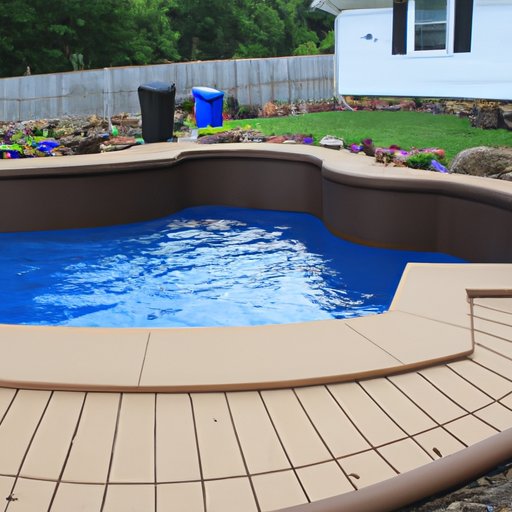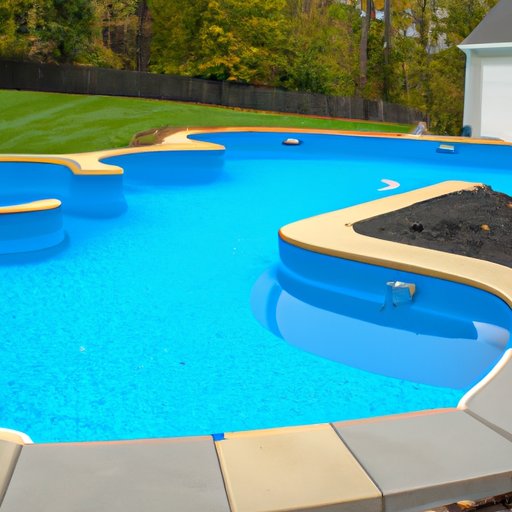Introduction
An inground pool is a great way to add value to your home and provide a place for friends and family to gather in the summer months. But before you jump into having one installed, it’s important to know how much an inground pool will cost.
The cost of an inground pool varies greatly depending on size, type, and features. In this article, we’ll explore the cost of an inground pool, including the average price of installation, the factors that influence the cost, and how to calculate the cost of an inground pool.

Inground Pool Cost: A Breakdown of What to Expect
According to the National Association of Home Builders (NAHB), the average cost of an inground pool is $35,000. This includes all of the materials and labor associated with the installation. However, this number can range from as low as $15,000 to as high as $100,000 or more, depending on the size, type, and features of the pool.
To get a better understanding of the cost of an inground pool, let’s take a look at the factors that impact the price.

Factors Impacting the Cost of Installing an Inground Pool
The cost of an inground pool is affected by several factors, including the type of pool, the size and shape of the pool, the materials used, and the features included.
For example, a vinyl-lined pool is typically the least expensive option, while fiberglass and concrete pools are usually more expensive. The size and shape of the pool also affects the price, as larger and more complex shapes require more materials and more labor. Additionally, features such as lights, decking, water features, and automated cleaning systems can add to the cost of the pool.

Inground Pool Costs: A Comprehensive Guide
Now that you have a better understanding of the factors that influence the cost of an inground pool, let’s take a closer look at the types of pools available and the cost of each.
Types of Inground Pools
There are three main types of inground pools: vinyl-lined, fiberglass, and concrete. Each has its own set of advantages and disadvantages when it comes to cost, maintenance, and longevity.
Vinyl-lined pools are the least expensive option, but they require more maintenance and need to be replaced every 8-10 years. Fiberglass pools are more durable and require less maintenance, but they tend to be more expensive than vinyl-lined pools. Concrete pools are the most expensive option, but they are more durable and customizable than other types of pools.
How Much Does it Cost to Install an Inground Pool?
The cost of installing an inground pool depends on the type of pool, the size and shape of the pool, and the features included. A basic vinyl-lined pool can cost as little as $15,000, while a more complex fiberglass or concrete pool can cost upwards of $50,000. Features such as lights, decking, and water features can add to the cost of the pool.
The High Cost of a Low-Cost Inground Pool
While a low-cost inground pool may seem like a good idea, it’s important to remember that the cost of maintaining and repairing a low-cost pool can quickly add up. According to a study by the American Society of Landscape Architects, the total cost of ownership for a low-cost inground pool is often twice as much as the cost of a higher-end pool.
The cost of repairs, chemicals, and equipment can add up quickly, so it’s important to factor in the long-term cost of ownership when calculating the cost of an inground pool.
Calculating the Cost of an Inground Pool
To get a better idea of the cost of an inground pool, it’s important to understand the different components and how they affect the overall price. Here’s a step-by-step guide to estimating the cost of an inground pool.
Step-by-Step Guide to Estimating Inground Pool Costs
1. Determine the size and shape of the pool. The size and shape of the pool will influence the cost of materials and labor.
2. Research the different types of pools available. Consider the pros and cons of each type of pool, such as cost, maintenance, and longevity.
3. Calculate the cost of materials. Take into account the cost of the pool liner, pumps, filters, and any other necessary materials.
4. Calculate the cost of labor. Consider the cost of excavation, installation, and any additional labor needed for the project.
5. Add in the cost of features. If you plan to include features such as lights, decking, or water features, make sure to factor in the cost of these items.
Understanding the Different Components of an Inground Pool
When calculating the cost of an inground pool, it’s important to consider the different components of the pool. These components include the liner, pump, filter, and other necessary equipment. Additionally, the cost of excavation and installation must be factored in. Finally, any features added to the pool, such as lights, decking, or water features, must be taken into account when calculating the cost of the pool.
Conclusion
Installing an inground pool can be a great way to add value to your home and provide a place for friends and family to gather. But before you jump into having one installed, it’s important to understand the cost of an inground pool.
The cost of an inground pool varies greatly depending on size, type, and features. On average, the cost of an inground pool is around $35,000. However, this number can range from as low as $15,000 to as high as $100,000 or more. It’s important to factor in the long-term cost of ownership when calculating the cost of an inground pool, as the cost of repairs, chemicals, and equipment can add up quickly.
To get a better idea of the cost of an inground pool, use a step-by-step guide to estimate the cost of the pool. Consider the size and shape of the pool, the type of pool, the cost of materials, the cost of labor, and the cost of any features added to the pool. With this information, you can get a better idea of the cost of an inground pool and determine if it’s the right investment for you.
Finally, here are a few tips for saving money on an inground pool installation: shop around for the best prices, look for discounts and promotions, and consider doing some of the work yourself.
(Note: Is this article not meeting your expectations? Do you have knowledge or insights to share? Unlock new opportunities and expand your reach by joining our authors team. Click Registration to join us and share your expertise with our readers.)
